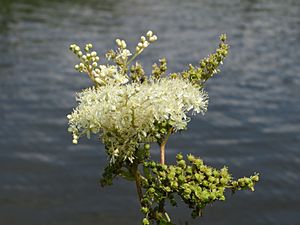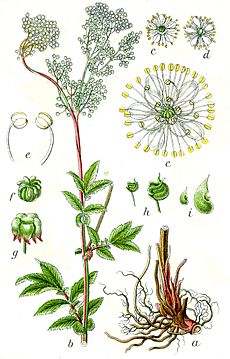Meadowsweet facts for kids
Quick facts for kids Meadowsweet |
|
|---|---|
 |
|
| Scientific classification | |
| Genus: |
Filipipendula
|
| Species: |
ulmaria
|
Filipendula ulmaria, often called meadowsweet, is a lovely wild plant. It's a perennial herb, meaning it lives for more than two years. This plant belongs to the rose family. You can find meadowsweet growing in wet places like damp meadows. It is native to most of Europe and Western Asia. It has also spread and grown naturally in North America.
Meadowsweet has many other fun names. Some people call it queen of the meadow or pride of the meadow. Other names include mead-wort, lady of the meadow, and bridewort.
Contents
What Meadowsweet Looks Like
Meadowsweet plants can grow quite tall, from about 3 to 6 feet (1 to 2 meters). Their stems stand straight up and can be reddish or even purple. The stems also have small ridges.
The leaves are dark green on top. Underneath, they look whitish and feel soft and fuzzy. Each leaf is divided into many smaller parts. The large leaflets at the end of the leaf are about 1.5 to 3 inches (4–8 cm) long. They often have three to five lobes, like small fingers.
Meadowsweet has beautiful, creamy-white flowers. These flowers grow close together in bunches called cymes. They have a very strong, sweet smell that many people enjoy. You can see them bloom from early summer until early autumn. Many different insects visit these flowers, especially Musca flies.
Each small flower has 5 sepals, which are like tiny leaves that protect the bud. It also has 5 petals and between 7 to 20 stamens. Stamens are the parts that hold the pollen.
Meadowsweet Diseases
Just like other plants, meadowsweet can get sick. Many insects and fungi can cause problems for it.
One common problem is caused by a bright orange-rust fungus called Triphragmium ulmariae. This fungus makes swellings or bumps, called galls, on the leaf stalks or the main vein of the leaf.
Another fungus, Ramularia ulmariae, causes purple spots to appear on the leaves.
There is also a fungus called Podosphaera filipendulae. This one causes mildew, which looks like a white powder, on the leaves and flower heads.
A tiny insect called the midge Dasineura ulmariae can also cause problems. It makes pinkish-white galls on the leaves. These galls can sometimes make the leaf surface look twisted or uneven.
Where Meadowsweet Gets Its Name
Meadowsweet has been known by many names over time. In an old story by Geoffrey Chaucer, it was called "meadwort." It was used in a special drink. It was also known as "bridewort" because people used to scatter it in churches for festivals and weddings. Sometimes, it was even made into garlands for brides. In Europe, it earned the name "queen of the meadow" because it can grow so much in low, wet meadows.
The name ulmaria means "like an elm tree." This might be because its individual leaves look a bit like those of an elm tree (Ulmus). Meadowsweet contains a substance called salicylic acid. This substance has been used for a long time to help with pain.
The scientific name, Filipendula, comes from two Latin words: filum, meaning "thread," and pendulus, meaning "hanging." This name describes the small, hanging root tubers that are found on the plant's fibrous roots.
Where Meadowsweet Grows
Meadowsweet is very common in the British Isles. It loves damp places and grows a lot in wet woods and marshy areas called fens.
It is often found in certain types of wet grasslands in Western Europe. These areas are known for having plants like Juncus subnodulosus (a type of rush) and Cirsium palustre (marsh thistle).
How Meadowsweet Is Used
The entire meadowsweet plant has a nice taste and smell. Even the green parts smell like the flowers. Because of its pleasant aroma, people used to scatter it on floors to make rooms smell good. It was also used to flavor wine, beer, and different kinds of vinegar. You can add the flowers to stewed fruit and jams to give them a subtle almond flavor.
Meadowsweet also has many medicinal uses. The whole plant has been a traditional remedy for an upset stomach. The fresh root is sometimes used in homeopathic medicines. When dried, the flowers are used in potpourri to add a sweet scent. It is also a popular spice in Scandinavian types of mead, which is an alcoholic drink made from honey.
The plant contains natural chemicals like salicylic acid, flavone glycosides, essential oils, and tannins. In 1897, a scientist named Felix Hoffmann made a changed version of salicin, which comes from plants like meadowsweet. This new drug, called aspirin, caused less stomach upset than pure salicylic acid. Aspirin was named by Hoffmann's employer, Bayer AG, after the old botanical name for meadowsweet, Spiraea ulmaria. This led to a whole group of medicines called non-steroidal anti-inflammatory drugs (NSAIDs), which help with pain and swelling.
You can also get a natural black dye from the roots of meadowsweet. This is done by using a copper mordant, which helps the dye stick to fabric.
In traditional Austrian herbal medicine, a tea made from meadowsweet flowers or leaves has been used to treat problems like rheumatism, gout, infections, and fever.
Meadowsweet in Culture
Meadowsweet flowers have been found with the remains of people and animals from the Bronze Age. These finds were in ancient burial mounds, like one at Fan Foel in Wales. Similar discoveries were made in old pots from Scotland. These findings might mean that people used meadowsweet to flavor honey-based mead or ale. Or, it could mean the plant was placed on graves because of its sweet smell.
In old Welsh mythology, there's a story about two magical figures, Gwydion and Math. They created a woman using blossoms from an oak tree, broom plants, and meadowsweet. They named her Blodeuwedd, which means "flower face."
In the 16th century, people often spread rushes and herbs on their floors. This helped keep rooms warm and made them smell better, also helping to prevent infections. Elizabeth I of England loved meadowsweet the most out of all the herbs. She wanted it in her rooms more than any other plant.




